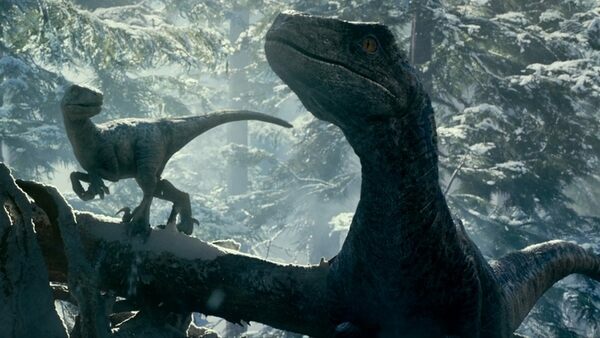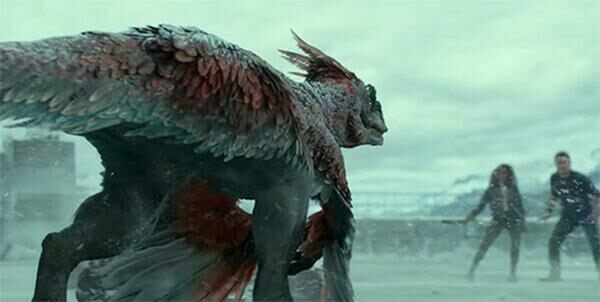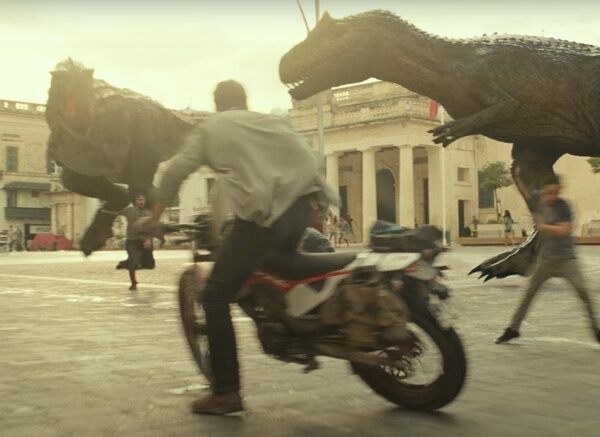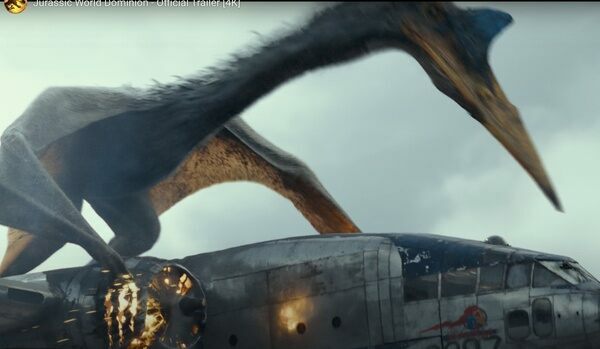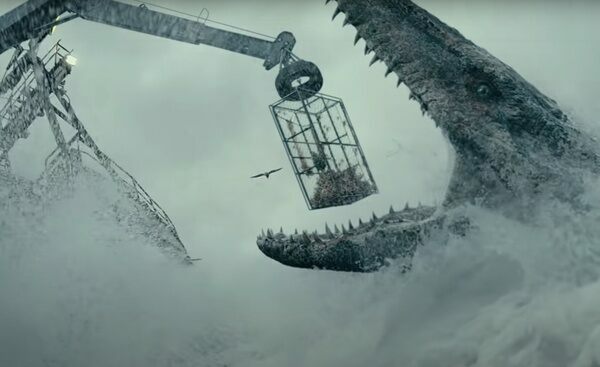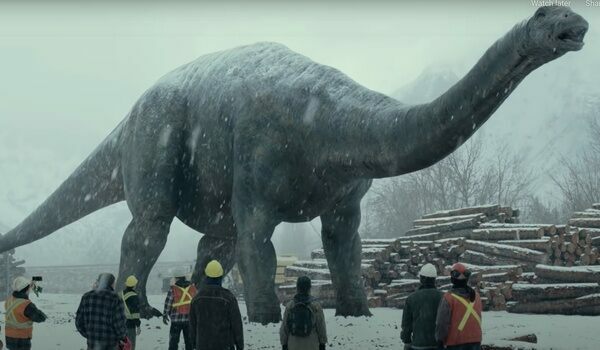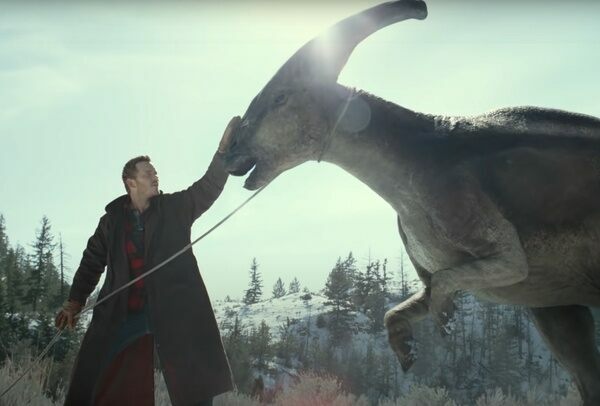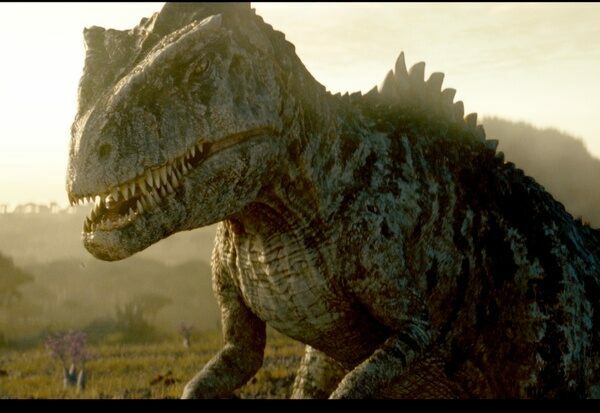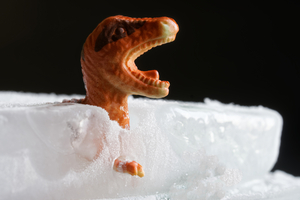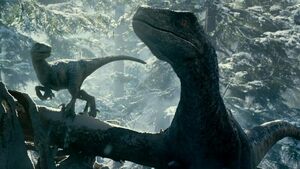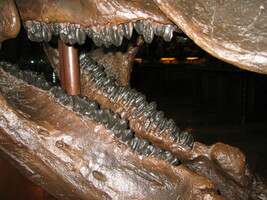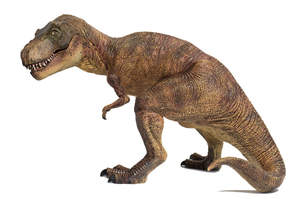Dinosaurs Set To Appear In Jurassic World: Dominion
Carnivores: Tyrannosaurus rex, Giganotosaurus, Velociraptor, Atrociraptor, Pyroraptor, Allosaurus, Carnotaurus, Dilophosaurus, Moros, Compsognathus, Anzu/Oviraptor, and some non-dinosaurian mesozoic reptiles, Pteranodon, Mosasaurus, and Quetzalcoatlus
Herbivores: Therizinosaurus, Apatosaurus, Parasaurolophus, Nasutoceratops, and Stygimoloch
Dominion Over Public Perception
The Jurassic Park series of films, and their sequels, the Jurassic World series, are possibly the most well known dinosaur-themed pieces of pop-culture in the past 30 years. From the first film in 1993, based on a bestselling novel of the same name, dinosaurs had been reintroduced and reimagined in popular consciousness based on much more up-to-date scientific research (for the time) than they had previously. No longer did the public think of dinosaurs as lumbering, cold-blooded, sluggish lizards, tantamount to movie monsters. Dinosaurs were finally being seen as a reasonable facsimile of what they really were; active, intelligent, real animals.
Over time, however, as the Hollywood machine kept moving and demand for higher-stakes, more action packed sequels swept audiences, scientific accuracy was forced to the backseat. This isn’t necessarily a bad thing, these aren’t documentaries after all–they’re meant to entertain, not educate.
However, for one reason or another, fans of both the series and paleontology in general love to pick apart the film’s dino designs. Accuracy in both appearance and behavior is played up or ignored to fit in line with audience tastes. A line from the character of Dr. Henry Wu in the first Jurassic World film even acknowledges this. “Nothing in Jurassic World is natural, we have always filled gaps in the genome with the DNA of other animals. And if the genetic code was pure, many of them would look quite different. But you didn’t ask for natural, you asked for more teeth.” Arguably, this, along with the explanation from the original films that frog, bird and lizard DNA is spliced with the incomplete dinosaur DNA, could rationalize (in a science-fiction sense), why the creatures in the film are significantly different from their real-life counterparts. Nevertheless, as a paleontology enthusiast and fan, I know I will always find it quite fun to pick apart and dissect the differences, and why, from a creative standpoint, these changes might have been made.
The latest film in the series, Jurassic World: Dominion, looks to have one of the largest dinosaur casts in series history, with reportedly over 30 different species of prehistoric creatures making an appearance in the film. Set to premiere in July, the film will follow Jurassic World’s protagonist, Owen Grady (Chris Pratt), along with the stars of the 1993 original, Alan Grant (Sam Neill), Ellie Sattler (Laura Dern), and Ian Malcolm (Jeff Goldblum), returning to their roles as co-protagonists. The film will follow the consequences of the last film in the series, 2018’s Jurassic World: Fallen Kingdom, the conclusion of which left a cavalcade of dinosaurs free to roam the American wilderness, and dinosaur DNA and cloning technology widely available for the more unscrupulous among society to exploit. Pre-release material shows a world where living dinosaurs have established themselves seemingly all across the world. Grady lassos some Parasaurolophus on horseback in the snowy wilderness of North America, is chased by Atrociraptors in what appears to be the Maltese city of Valleta, and is attacked in a plane by a gigantic Quetzalcoatlus over mountainous terrain.
Returning favorite dinosaurs are set to reappear in the upcoming sequel. The Tyrannosaurus “Rexy”, in-universe the same Tyrannosaurus from the original 1993 film, appears in the same snowy climes as the aforementioned Parasaurolophus. Blue, the Velociraptor from the previous Jurassic World films, also returns, rearing a chick named “Beta”. The Mosasaur which devoured the antagonistic “Indominus rex” from the first Jurassic World film, and which cameoed in the sequel, is seen capsizing a fishing boat in pursuit of the trawler’s quarry.
In addition to these, many new prehistoric creatures are set to debut in the film. Replacing the Velociraptors of the previous films, the antagonistic “raptors” of this movie are all considered Atrociraptors, a different genus. But Atrociraptors aren’t the only new raptors set to appear. Pyroraptor will also be making its first appearance on film, and is notable for its film version’s bright and extensive feathering, a first for the series. Other notable beasties include the aforementioned Quetzalcoatlus attacking a plane mid-flight, the ceratopsian Nasutoceratops stampeding through a campsite, and the film’s obligatory antagonistic mega-theropod, Giganotosaurus, glowering at the main cast in a dark, forested environment.
Carnivores
Debatably the most famous dinosaur of all, in no small part due to its appearance in this very series. The T.rex that appears in the Jurassic World series, dubbed “Rexy” by fans, is the same individual Tyrannosaurus from the 1993 original. In reality, this would make this individual exceptionally old. If we assume that the T.rex in 1993 was around 15-20 years old, about the age when a Tyrannosaurus rex would have reached physical maturity, this would mean that the same individual in 2022 would be 45-50 years old! For reference, one of the oldest known individual Tyrannosaurus specimens, known as “Scotty”, was about 30 years old when it died. So Dominion’s Rexy would, in more realistic terms, be the T.rex equivalent of a little old lady. Physically, the Tyrannosaurus in the Jurassic series is similar to the real animal, with some notable differences. Tyrannosaurus rex, in reality, was a bulky, robust dinosaur. The one portrayed in the films is certainly large, but is slimmer in the front of its torso, and has a head with skin more tightly wrapped around the skull, giving it a more fearsome appearance. This “shrink-wrapping” of the skin is somewhat common in paleoart, wherein little regard is given to the fat and muscle that the animal would have had in life, making the depiction skinnier and more malnourished looking than reality. Lastly, one of the more famous misconceptions about T.rex popularized by these films is its poor eyesight. In reality, studies on the braincase of Tyrannosaurus indicate that the parts of its brain dedicated to sensory perception would have been quite large. This means that Tyrannosaurus would certainly have seen you, no matter how little you moved.
Another quite famous theropod from the series are the cold, cunning “Raptors”, scientifically referred to as Dromaeosaurs. Velociraptors are featured in every film in both series, and have taken a much more developed role in the Jurassic World series, with the introduction of named raptors. “Blue”, in particular, has become something of a mascot for the JW series, casting the normally villainous raptors in a more positive light. In a more infamous bit of paleo trivia, the very first JP film starts at a fossil dig site, excavating a Velociraptor specimen. In reality, this errant raptor would have been very far from home, considering V. mongoliensis is native to central asia! The velociraptors in the book, notably, are not based on V.mongoliensis, however. When writing, the late Michael Crichton based the raptors in his novel on what was then called “Velociraptor antirrhopus”, thought to be a larger species of Velociraptor, which was renamed after publishing to “Deinonychus antirrhopus”. Deinonychus would still not reach the size portrayed in the movie, however the related species, Utahraptor ostrommaysi, discovered concurrently with the filming of Jurassic Park, would have easily reached the 10 foot (3m) length of the raptors in the film.
Being introduced to the public in the latest installment are 2 recently discovered dromaeaosaurs, Atrociraptor and Pyroraptor. Atrociraptor seems to be replacing Velociraptor as the antagonistic representative of the dromaeosauridae, seen in trailers doggedly pursuing protagonist Owen Grady. Meanwhile, Pyroraptor represents a Jurassic series first; namely, feathered dinosaurs. The beastie is seen puffing out its feathery coat in what appears to be a threat display, before charging at our protagonists. Both of these species seem to be receiving the Velociraptor treatment, being significantly larger than their real-world counterparts. In addition, all three of these species show phylogenetic evidence of having a coat of feathers, not just Pyroraptor.
Our first dinosaur actually from the Jurassic period, Allosaurus was a large, 30-foot (9m) allosauroid predator from the Morrison formation of North America, with some material coming from Portugal. For its day, it was the top predator, feeding on any animal it could. It made its Jurassic premiere with a short appearance in Fallen Kingdom, shrieking at the protagonists as they attempted to outrun a volcanic eruption. It also appears as the antagonistic dino in the promotional short film, Battle at Big Rock, where it terrorizes a family of campers. In the upcoming Dominion, Allosaurus seems to have a much larger portrayal, in both senses of the word. It shares a rampage with the Cretaceous dinosaur Carnotaurus in what appears to be the Maltese city of Valleta, where it seems to be much larger than its real life counterpart. There is evidence of larger Allosaurus specimens, however. The related genus Epanterias, which may in fact be synonymous with Allosaurus, is estimated to possibly have been 40 feet (12.5m) long, closer to what is seen in the movie.
Bringing us back to the Cretaceous is Carnotaurus, an abelisaur known from Patagonia. Introduced in the previous installment, Fallen Kingdom, Carnotaurus appeared as a minor threat, and shared in devouring the film’s human antagonist with the Tyrannosaurus like a gory rendition of lady and the tramp. It appears to be taking a similar role in this next entry in the series, stomping around Valleta alongside Allosaurus. Like the Allosaurus, it appears to be sized up from its average 25-foot (8m) length to increase the “cool” factor, however there is evidence for larger abelisaurs existing. Pycnonemosaurus, a relative of Carnotaurus, could reach nearly 30 feet (9m) in length, and an unnamed Abelisaur from Libya may have reached nearly 36 feet (11m). Carnotaurus was likely chosen for the impressive looking horns adorning its brow.
Carnivorous dinosaurs aren’t the only Mesozoic monsters gracing the silver screen this July. Pteranodon, the crested pterosaur with a 25 foot (8m) wingspan returns from the previous films, swarming around in a scene depicting an airplane attack. Making its debut with the returning pteranodon, Quetzalcoatlus appears to tear the plane apart. Using the plane as a reference, fans have placed the size of the film’s Quetzalcoatlus as between 70-90 feet (23-29m) in bodily length, though this could be just for the shots we see, a trick often used in monster and cgi heavy productions. In reality Pteranodon would likely have been largely piscivorous, using its beak to skim the open ocean for surface dwelling fish. It would also have been covered in a fuzzy layer of hair-like “Pycnofibers”, which would have insulated the animal, and kept it from looking as gargoyle-esque as it does in the film. Interestingly, the featured Quetzalcoatlus seems to have this fuzz in the movie. Quetzalcoatlus was thought to have been a plains dwelling generalist carnivore, stalking the grasslands of North America, picking up and devouring any small vertebrates it could find whole, and picking apart carrion. It is highly unlikely that it would have the strength required to tear apart a metal airplane, nor would it have the speed to keep up with one. Additionally, it would only have been about a third of the size it appears to be in the film, with a wingspan of about 36 feet (12m).
And to round out from the land and sky to the depths of the sea, there’s the positively enormous Mosasaurus. First appearing on-screen in Jurassic World, the Mosasaurus immediately drew attention for being wildly oversized. In reality, the largest Mosasaurus species, Mosasaurus hoffmanni, reached a length of about 56 feet (16-17m). In the film, its size is uncertain, changing somewhat from shot to shot, but fans, using objects in the frame as reference points (such as the shark it gets fed in the first JW film) have recorded measurements of 100 feet (36m) to nearly 300 (Approx. 76m). Perhaps a size like this is why it seems to so easily be able to capsize a large fishing vessel by tugging on its quarry. Interestingly, in the films, it feeds similarly to a crocodile, jumping out of the shadows to drag prey below the water. However, as an open ocean predator, it is much more likely that Mosasaurus would have ambushed and devoured prey with its mouthful of sharp teeth, rather than feed at the shoreline like a croc.
Herbivores
Just because we’ve moved onto herbivores, doesn’t mean we’re done talking about theropods. Making a big screen debut in Jurassic World Dominion, the scythe lizard Therizinosaurus appears to have a menacing air about it in the upcoming film. Seen stalking the female lead, Claire Dearing (Bryce Dallas Howard), in what appears to be a swampy wetland, it screeches menacingly in her vicinity. Despite having massive claws, however, Therizinosaurus was not likely to stalk prey through the forests of Cretaceous Mongolia, where it originates. A skull of Therizinosaurus has never been recovered, however related species indicate a relatively small skull on a longer neck, which the movie seems to abide by. This would have suited its primarily herbivorous lifestyle. The movie also correctly gives Therizinosaurus a coat of feathers, as well as a rough beak. Its head does appear a bit more robust, perhaps to make it look like a more monstrous animal for the film. Its huge claws were likely used in life to pull at large plants, helping it graze at mid-level flora.
Apatosaurus is one of the most well known diplodocoid sauropod dinosaurs. It was one of the earliest discovered sauropods, and one of the most complete known at the time of discovery in 1877. Measuring 69-75 feet (21-23m) in length and weighing over 22 tons, Apatosaurus was one of the quintessential long-necked dinosaurs. Visually, the animal in the film is very similar to how it would have looked in life, if a bit skinnier than it should be. However herbivores tend to be underplayed as docile and peaceable creatures in these films, set-dressing meant to inspire awe or feed ever-hungrier, toothier carnivores. While dinosaur behavior is largely conjecture based on living animals and physical features, if we look at large herbivores in nature today, many are far from being open and calm when faced with other animals. Hippos will bite crocodiles in half, and chase humans from their territory. Elephant tusks aren’t just for show, and neither are the horns of a rhinoceros. And while Sauropods didn’t have visually impressive defense mechanisms like tusks or horns, they were certainly massive enough to be formidable in their own right.
Parasaurolophus was a crested hadrosaur, well known for its large, prominent head crest. Over the years since its discovery, many uses had been posited for the crest, from social signaling, heat exchange, even as a snorkel. The modern interpretation generally agrees that the crest served as both a visual and audio signal to others of its kin. It was able to make high and low frequency cries because of the resonating chamber inside its long, tubular crest, connected to its nasal cavity. As the films depict, Parasaurolophus was facultatively bipedal, meaning that it had the ability to walk bipedally when it needed to, likely to run faster. This would have come in handy, as Parasaurolophus coexisted with large theropods like tyrannosaurids. Jurassic World Dominion actually represents the second time in the film series that the ornithopod will be chased and lassoed, the first time being in The Lost World: Jurassic park.
Seemingly replacing the more well known Triceratops, Nasutoceratops returns from its appearances in Jurassic World: Fallen Kingdom and the promotional short Battle at Big Rock to stampede into theaters this July. The centrosaurine ceratopsian was smaller than its more famous relative, being about 16 feet (4m) long compared to Triceratops’ 28 feet (8.5m), but bore a strong resemblance, having a large frill and 2 prominent brow horns. Instead of Triceratops’ nose horn, however, Nasutoceratops had a raised bump over its nasal area, giving its skull an arched appearance. Nasutoceratops’ horns are also curved out and forward, giving them a more cattle-like appearance than Triceratops.
Stygimoloch also makes a return from the prior film, where it filled an almost comic-relief role, battering people and objects with its rough, domed skull. Stygimoloch was a member of the pachycephalosaurids, a group known for having reinforced skulls. Stygimoloch, however, is something of a contentious species. There is a semi-settled debate as to whether Stygimoloch and the contemporaneous genera Dracorex and Pachycephalosaurus are in fact different species, or whether they are instead different growth stages of a single species. The general consensus in the paleontological community has lumped Stygimoloch and Dracorex into the genus Pachycephalosaurus, citing the immature growth of bone in the two other supposed species. The “Stygimoloch” in the film bears a greater resemblance to an adult Pachycephalosaurus in both size and skull shape, as a “Stygimoloch” skull would not have bulged and rounded out into a dome at the stage of life it was in.
Cameos And Minor Monsters
Many dinosaurs seem to have smaller roles in the film as well, flashing clips showcase Dilophosaurus, one of the more primitive dinosaurs on the cast. Dilophosaurus was, in life, one of the most different dinosaurs from its Jurassic franchise counterpart. The film version was much smaller, had a head shape more similar to a larger, more derived theropod, and perhaps most notably, possessed a flashy skin hood that flares out like a frilled lizard, and spits an acidic venom. In life, Dilophosaurus was a basal dinosaur, with traits resembling the early theropods. It had a notched, narrow jaw, and 2 prominent semi-circle shaped crests, which its film counterpart does share. It was much larger than the reptile featured on screen, being around 22 feet (7m) in length. Compsognathus, a diminutive Jurassic theropod in the coelurosaur group, cameos as a skeletal reconstruction. As they have featured prominently in the prior films, perhaps the same can be expected of the upcoming film. Anzu, a recently discovered oviraptorid dinosaur, also seems to make an appearance, although some suggest it may be the more well-known, related dinosaur, Oviraptor. Oviraptor, meaning “Egg Thief”, was discovered in Mongolia atop a nest of eggs, and erroneously thought to have been feasting on them. In reality, upon further research, it was discovered that the eggs were in fact, likely the Oviraptor’s own clutch. The upcoming film however, seems to be abiding by the popular misconception, depicting the animal sneaking upon and attempting to snack on a nest of eggs. Moros, a small, basal Cretaceous tyrannosaur, and one of the earliest known North American tyrannosaurs, is shown picking the teeth of a certain larger theropod…
Big, Green, And Really Mean
Last but certainly not least, these films would never be complete without a scary, giant, antagonistic theropod to terrorize the characters and audience alike. In the prior films, the writers seemed to dip into the more fantastical elements of their sci-fi setting, creating genetic hybrids to duke it out with our more well known favorites. In Jurassic World: Dominion, it seems, they’ll be bringing us back to a slightly more grounded vision of a mesozoic monster.
In the film’s prologue, released ahead of the film as a promotional video, a window is opened into the universe’s interpretation of the Hell Creek formation of Late Cretaceous North America. Several anachronous or geographically inaccurate species are depicted living in this temperate environment, and a Tyrannosaurus seems to rule the area. However, it is challenged by a larger theropod, and killed before the transition to the modern era. But who was this monster theropod that could possibly challenge and defeat the tyrant lizard king?
Giganotosaurus is the name of the beast, and it certainly lives up to the title of “Giant Southern Reptile”. Measuring at roughly the same length as Tyrannosaurus, if not longer, Giganotosaurus made headlines upon its discovery in Patagonia, with some outlets claiming that the tyrant lizard had been dethroned. Though its size is difficult to pin down due to incomplete remains, Giganotosaurus is generally thought to be longer than Tyrannosaurus, with most estimates placing it around 45 feet (14m), and about the same weight of 8 or so tons. Some have argued that Tyrannosaurus would have been heavier, citing features such as the diameter of the femur in both species. While others point out that the leg proportions feature other dissimilarities, with the femur of T.rex being shorter, while the tibia of Giganotosaurus was shorter than Tyrannosaurus’. Giganotosaurus’ skull was longer than T.rex’s, at about 6 feet (2m) in length, and shows evidence of being able to close very rapidly. Giganotosaurus was a member of the carcharodontosauridae family, meaning that its teeth were triangular, flat and serrated, built for slicing into prey and tearing off chunks of meat. These features in tandem would have made Giganotosaurus a fearsome predator indeed, with some scientists suggesting that the animal may have hunted juvenile sauropods.
But could even a predator like Giganotosaurus so easily dispatch the North American tyrant? Well, it was unlikely that they ever met in the first place. Tyrannosaurus lived in North America, while Giganotosaurus was isolated to South America. They also lived about 30 million years apart, with Giganotosaurus being approximately 95-100 million years old, while Tyrannosaurus lived at the end of the Mesozoic era, around 65-67 million years ago. The related dinosaur Acrocanthosaurus was North American, but even older than Giganotosaurus, being around 100-125 million years old, while no Tyrannosaurs ever inhabited South America..
The film’s version of the massive theropod has a tapering, triangular head, with high brow ridges and a thick ridge along its back, lined with crocodile-like scutes. Its skin seems to be covered in scute-like plating as well, giving it an armored appearance. This was likely to increase the animal’s antagonistic appearance, looking like a bigger, badder, meaner theropod. In reality, the animal would have had a rounder snout, with no evidence of brow ridges as pronounced as the film’s depiction. Its vertebrae do show signs of higher than average processes, but not nearly enough to produce the pronounced ridge of the movie’s version. The more tapered snout and brow ridges make it look similar to its allosauroid ancestors. There are currently no known skin impressions of Giganotosaurus, so while it isn’t impossible that the animal could have had crocodile-like scales, it is unlikely based on scale impressions of other large theropods.
The film depicts Giganotosaurus as the victor of the duel in the prologue, with the implication that the Tyrannosaurus that is killed is fed on by a mosquito, and is cloned to create the T.rex in Jurassic Park. In typical monster movie fashion, this will likely set the stage for a comeback battle by movie’s end, where the Tyrannosaur may get its revenge via her cloned kin. However, since the film is unreleased at this time, any number of outcomes may happen!
Get Your Accuracy Tickets At The Botch Office
Jurassic Park and its subsequent sequels are practically synonymous with the pop culture quintessence of everything mesozoic. The first film’s breakout success reinvented the public’s opinions and idea of what a dinosaur could look like, introducing ideas that scientists had discovered years earlier. Many still had the opinion that dinosaurs were slow, lethargic, and sluggish, like some modern reptiles, while the film pointed out several features of dinosaurs that made it clear that dinosaurs were much more active animals, related to modern birds.
However, they are certainly not documentaries, and in other ways, they have continued or outright created popular myths and misconceptions about dinosaurs. Tyrannosaurus could see whether you were moving or not. Velociraptors were 2 feet tall and were covered in feathers. Oviraptor was a roosting parent, not an egg-snatcher, and herbivores were more than just snack fodder for constantly bloodthirsty carnivores.
The further we move from 1993, the more and more the series seems to dig its heels into the past, keeping species too small, too large, too bald, or otherwise distorted from their real-life counterparts. Still, steps are made to include new discoveries in the films, 2003’s Jurassic Park III introduced the then-recently redescribed Spinosaurus as the acting antagonist, and even coincidentally depicted it as a semi-aquatic predator years before there was evidence to suggest that. Jurassic World: Dominion seems set to debut fully feathered theropods, something that has been common knowledge to paleontologists for years. It is always important to keep a critical eye open when watching movies, and while there’s nothing wrong with watching escapist fantasy, it should be remembered that fantasy is exactly what is portrayed, not reality.
 Reviews
Reviews
